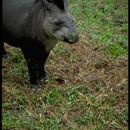Biology
(
Anglèis
)
fornì da Arkive
There is a paucity of knowledge regarding the natural ecology and behaviour of all tapirs; previously thought to be solitary, recent evidence suggests that the social organisation consists of pairs, and that tapirs may congregate at salt-licks (7). Typically active between late afternoon and early morning, mountain tapirs rest in dense vegetation for most of the day (8) and are very sure-footed, negotiating perilously steep mountain slopes with apparent ease (5). Like all tapirs, this species is fond of water and wallowing in mud (2). It browses and grazes on a variety of seeds, foliage and shoots, and is an important seed disperser for certain tree species (2). Within an individual's range the major water and food sources, sleeping and feeding areas are connected by well-trodden pathways (5).
The existence of a distinct breeding season is yet to be determined but in the wild tapirs appear to reach sexual maturity at between two and three years old (7). One calf is produced every couple of years, and stays with the mother for between one and two years (7). Mountain tapirs communicate by producing shrill bird-like whistles (8), and males mark the boundaries of their territory by urinating (6).
Conservation
(
Anglèis
)
fornì da Arkive
The mountain tapir occurs in a number of protected reserves in Colombia and Ecuador, and is protected throughout most of the current range (2). A small number of individuals currently live in captivity at a handful of zoos (2). The Tapir Preservation Fund was set up in 1996; the aims of this organisation include the promotion of the conservation and study of tapirs. (9). It has been highlighted that local people must be involved in, and benefit economically from, programmes to conserve this species if they are to be successful in preventing poaching and habitat loss (6).
Description
(
Anglèis
)
fornì da Arkive
The mountain tapir is a 'living fossil' (5); the smallest (6) of four surviving species of tapir that represent the remnants of a lineage that evolved around 55 million years ago, after the demise of the dinosaurs (5). The mountain tapir is also known as the 'woolly tapir' due to its thick, woolly reddish-brown to black fur (5). The tips of the ears are white and some tapirs have a whitish band between the feet and hooves (7). The lips and nose are drawn into a prehensile proboscis, a feature shared by all living tapirs (5). Infants under one year of age are reddish-brown in colour with a series of white stripes and spots (5). Females tend to be slightly larger than males, but are otherwise very similar in appearance (3).
Habitat
(
Anglèis
)
fornì da Arkive
Inhabits mid and high-level montane cloud forest between 2000 and 4000 metres (2), alpine meadows and páramo grasslands (treeless moorland) (5).
Range
(
Anglèis
)
fornì da Arkive
Endemic to the Andes Mountains of north-western South America (2), small numbers remain in north-western Peru, Colombia and Ecuador (5). It has become extinct in northern Colombia and possibly from western Venezuela although there is some doubt as to whether the range ever extended this far (7). The population is currently estimated to number fewer than 2,500 individuals (3).
Status
(
Anglèis
)
fornì da Arkive
Classified as Endangered (EN) by the IUCN Red List 2007 (1), and listed on Appendix I of CITES (4).
Threats
(
Anglèis
)
fornì da Arkive
The major threats to the mountain tapir are destruction and fragmentation of the páramo and cloud forest habitats, coupled with illegal hunting for food (2) (3), and the use of body parts in folk medicine (6). The introduction of livestock to the area may have significant effects through transmitting diseases and attracting increased numbers of predators (2).

